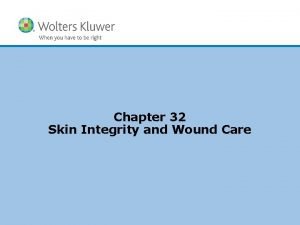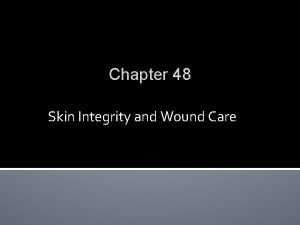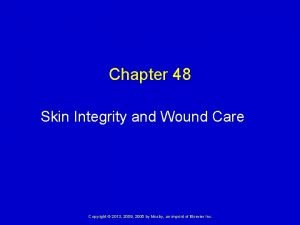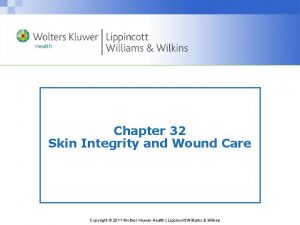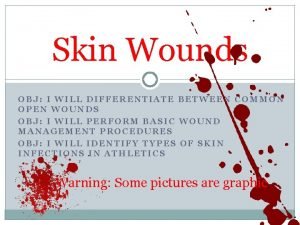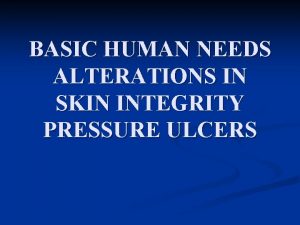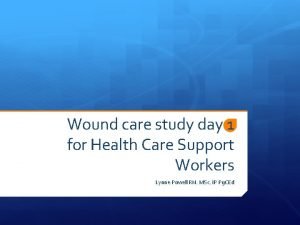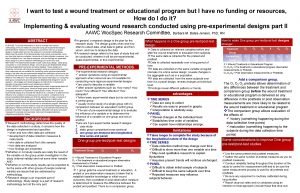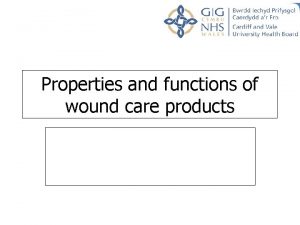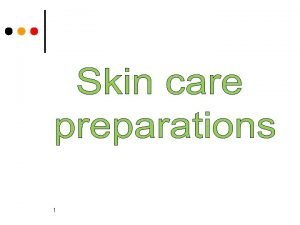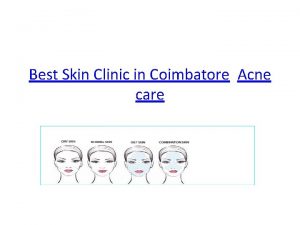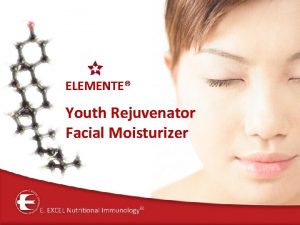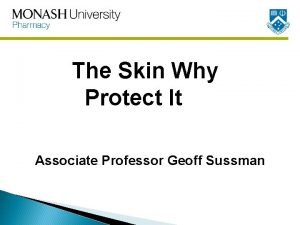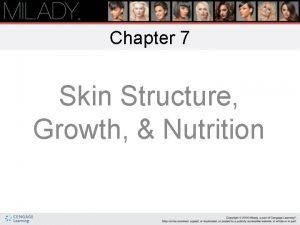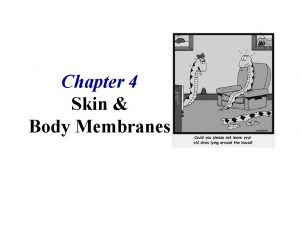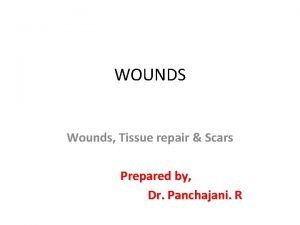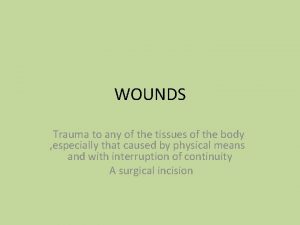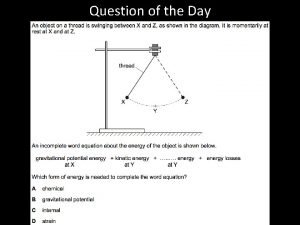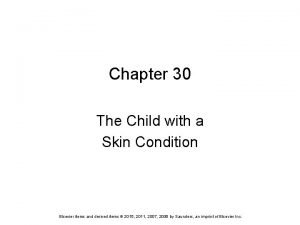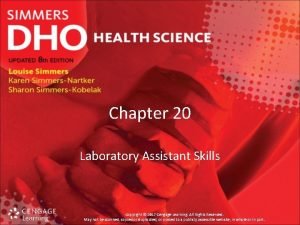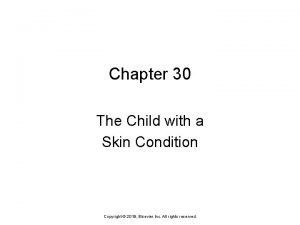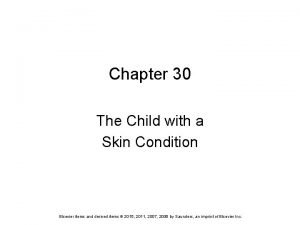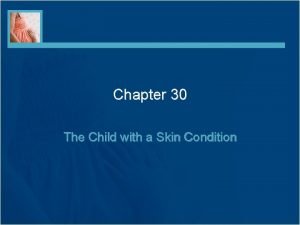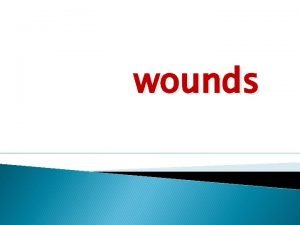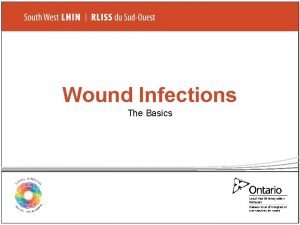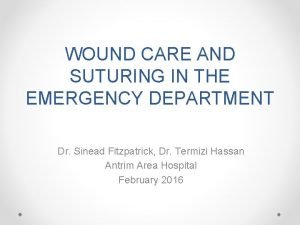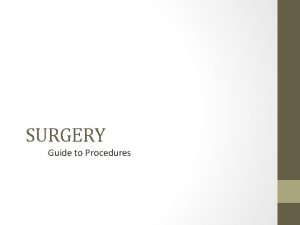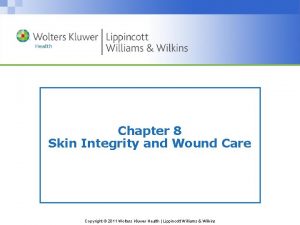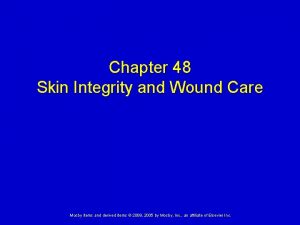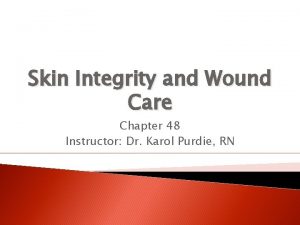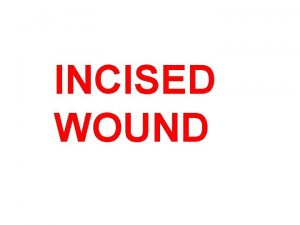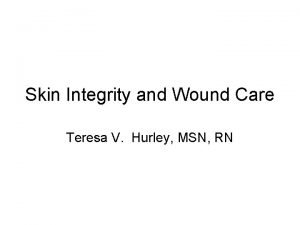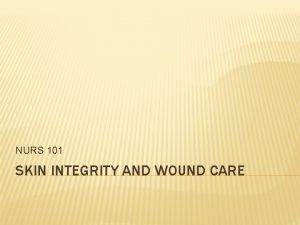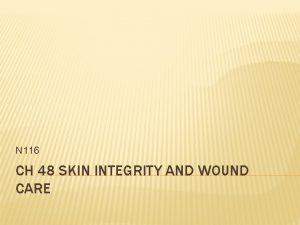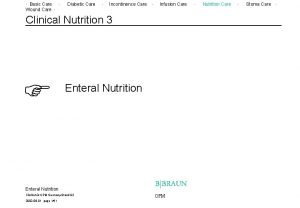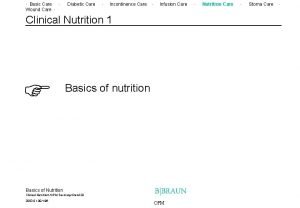Chapter 32 Skin Integrity and Wound Care Copyright





















































- Slides: 53

Chapter 32 Skin Integrity and Wound Care Copyright © 2011 Wolters Kluwer Health | Lippincott Williams & Wilkins Copyright © 2019 Wolters Kluwer • All Rights Reserved

Functions of the Skin v Protection v Body temperature regulation v Psychosocial v Sensation v Vitamin D production v Immunologic v Absorption v Elimination Copyright © 2019 Wolters Kluwer • All Rights Reserved

Question #1 Tell whether the following statement is true or false. Blood vessels in the skin dilate to dissipate heat. A. True B. False Copyright © 2019 Wolters Kluwer • All Rights Reserved

Answer to Question #1 Answer: A. True Rationale: Blood vessels in the skin dilate to dissipate heat. Copyright © 2019 Wolters Kluwer • All Rights Reserved

Cross-Section of Normal Skin Copyright © 2019 Wolters Kluwer • All Rights Reserved

Factors Affecting the Skin v Unbroken and healthy skin and mucous membranes defend against harmful agents. v Resistance to injury is affected by age, amount of underlying tissues, and illness. v Adequately nourished and hydrated body cells are resistant to injury. v Adequate circulation is necessary to maintain cell life. Copyright © 2019 Wolters Kluwer • All Rights Reserved

Developmental Considerations v In children younger than 2 years, the skin is thinner and weaker than it is in adults. v An infant’s skin and mucous membranes are easily injured and subject to infection; a child’s skin becomes increasingly resistant to injury and infection. v The structure of the skin changes as a person ages; the maturation of epidermal cells is prolonged, leading to thin, easily damaged skin. v Circulation and collagen formation are impaired, leading to decreased elasticity and increased risk for tissue damage from pressure. Copyright © 2019 Wolters Kluwer • All Rights Reserved

Causes of Skin Alterations v Very thin and very obese people are more susceptible to skin injury. o Fluid loss during illness causes dehydration. o Skin appears loose and flabby. v Excessive perspiration during illness predisposes skin to breakdown. v Jaundice causes yellowish, itchy skin. v Diseases of the skin, such as eczema and psoriasis, may cause lesions that require special care. Copyright © 2019 Wolters Kluwer • All Rights Reserved

Types of Wounds v Intentional or unintentional v Open or closed v Acute or chronic v Partial thickness, full thickness, complex Copyright © 2019 Wolters Kluwer • All Rights Reserved

Question #2 Which type of wound is caused by a blunt instrument that causes injury to underlying soft tissue with the overlying skin remaining intact? A. Contusion B. Abrasion C. Laceration D. Avulsion Copyright © 2019 Wolters Kluwer • All Rights Reserved

Answer to Question #2 Answer: A. Contusion Rationale: A contusion is caused by a blunt instrument and may result in bruising or hematoma. An abrasion is the rubbing or scraping of epidermal layers of skin. A laceration is the tearing of skin and tissue with a blunt or irregular instrument. Avulsion is the tearing of a structure from normal anatomic position. Copyright © 2019 Wolters Kluwer • All Rights Reserved

Principles of Wound Healing #1 v Intact skin is the first line of defense against microorganisms. v Careful hand hygiene is used in caring for a wound. v The body responds systematically to trauma of any of its parts. v An adequate blood supply is essential for normal body response to injury. v Normal healing is promoted when the wound is free of foreign material. Copyright © 2019 Wolters Kluwer • All Rights Reserved

Principles of Wound Healing #2 v The extent of damage and the person’s state of health affect wound healing. v Response to wound is more effective if proper nutrition is maintained. Copyright © 2019 Wolters Kluwer • All Rights Reserved

Phases of Wound Healing v Hemostasis v Inflammatory v Proliferation v Maturation Copyright © 2019 Wolters Kluwer • All Rights Reserved

Question #3 In which phase of wound healing is new tissue built to fill the wound space, primarily through the action of fibroblasts? A. Hemostasis B. Inflammatory phase C. Proliferation phase D. Maturation phase Copyright © 2019 Wolters Kluwer • All Rights Reserved

Answer to Question #3 Answer: C. Proliferation phase Rationale: In the proliferation phase, granulation tissue is formed to fill the wound. In hemostasis, involved blood vessels constrict and blood clotting begins. In the inflammatory phase, white blood cells move to the wound. In the maturation phase, collagen is remodeled, forming a scar. Copyright © 2019 Wolters Kluwer • All Rights Reserved

Hemostasis v Occurs immediately after initial injury v Involved blood vessels constrict and blood clotting begins. v Exudate is formed, causing swelling and pain. v Increased perfusion results in heat and redness. v Platelets stimulate other cells to migrate to the injury to participate in other phases of healing. Copyright © 2019 Wolters Kluwer • All Rights Reserved

Inflammatory Phase v Follows hemostasis and lasts about 2 to 3 days v White blood cells, predominantly leukocytes and macrophages, move to the wound. v Macrophages enter the wound area and remain for an extended period. v They ingest debris and release growth factors that attract fibroblasts to fill in the wound. v The patient has a generalized body response. Copyright © 2019 Wolters Kluwer • All Rights Reserved

Proliferation Phase v Lasts for several weeks. v New tissue is built to fill the wound space through the action of fibroblasts. v Capillaries grow across the wound. v A thin layer of epithelial cells forms across the wound. v Granulation tissue forms a foundation for scar tissue development. Copyright © 2019 Wolters Kluwer • All Rights Reserved

Maturation Phase v Final stage of healing; begins about 3 weeks after the injury, possibly continuing for months or years. v Collagen is remodeled. v New collagen tissue is deposited. v Scar becomes a flat, thin, white line. Copyright © 2019 Wolters Kluwer • All Rights Reserved

Local Factors Affecting Wound Healing v Pressure v Desiccation (dehydration) v Maceration (overhydration) v Trauma v Edema v Infection v Excessive bleeding v Necrosis (death of tissue) v Presence of biofilm (thick grouping of microorganisms) Copyright © 2019 Wolters Kluwer • All Rights Reserved

Systemic Factors Affecting Wound Healing v Age: children and healthy adults heal more rapidly v Circulation and oxygenation: adequate blood flow is essential v Nutritional status: healing requires adequate nutrition v Wound etiology: specific condition of the wound affects healing v Health status: corticosteroid drugs and postoperative radiation therapy delay healing v Immunosuppression v Medication use v Adherence to treatment plan Copyright © 2019 Wolters Kluwer • All Rights Reserved

Wound Complications v Infection v Hemorrhage v Dehiscence and evisceration v Fistula formation Copyright © 2019 Wolters Kluwer • All Rights Reserved

Question #4 Which wound complication is caused by overhydration related to urinary and fecal incontinence? A. Necrosis B. Edema C. Desiccation D. Maceration Copyright © 2019 Wolters Kluwer • All Rights Reserved

Answer to Question #4 Answer: D. Maceration Rationale: Maceration is caused by overhydration related to incontinence that causes impaired skin integrity. Necrosis is dead tissue present in the wound that delays healing. Edema is swelling at a wound site that interferes with blood supply to the area. Desiccation is the process in which the cells dehydrate and die. Copyright © 2019 Wolters Kluwer • All Rights Reserved

Wound Dehiscence and Evisceration Copyright © 2019 Wolters Kluwer • All Rights Reserved

Psychological Effects of Wounds v Pain v Anxiety v Fear v Impact on activities of daily living v Change in body image Copyright © 2019 Wolters Kluwer • All Rights Reserved

Factors Affecting Pressure injury Development v Aging skin v Chronic illnesses v Immobility v Malnutrition v Fecal and urinary incontinence v Altered level of consciousness v Spinal cord and brain injuries v Neuromuscular disorders Copyright © 2019 Wolters Kluwer • All Rights Reserved

Mechanisms in Pressure Injury Development v External pressure compressing blood vessels v Friction or shearing forces tearing or injuring blood vessels Copyright © 2019 Wolters Kluwer • All Rights Reserved

Stages of Pressure injuries v Stage 1: nonblanchable erythema of intact skin v Stage 2: partial-thickness skin loss with exposed dermis v Stage 3: full-thickness skin loss; not involving underlying fascia v Stage 4: full-thickness skin and tissue loss v Unstageable: obscured full-thickness skin and tissue loss v Deep tissue pressure injury: persistent nonblanchable deep red, maroon, or purple discoloration Copyright © 2019 Wolters Kluwer • All Rights Reserved

Measurement of a Pressure injury v Size of wound v Depth of wound v Presence of undermining, tunneling, or sinus tract Copyright © 2019 Wolters Kluwer • All Rights Reserved

Pressure Ulcer Scale for Healing (PUSH) PUSH Tool 3. 0 Copyright © 2019 Wolters Kluwer • All Rights Reserved

Question #5 Tell whether the following statement is true or false. A stage 3 pressure injury requires débridement through wet-to-dry dressings, surgical intervention, or proteolytic enzymes. A. True B. False Copyright © 2019 Wolters Kluwer • All Rights Reserved

Answer to Question #5 Answer: A. True Rationale: A stage 3 pressure injury requires débridement through wet-to-dry dressings, surgical intervention, or proteolytic enzymes. Copyright © 2019 Wolters Kluwer • All Rights Reserved

Cleaning a Pressure Injury/Wound v Clean with each dressing change. v Use new gauze for each wipe and clean from top to bottom and/or from the center to the outside. v Use 0. 9% normal saline solution to irrigate and clean the injury. v Once the wound is cleaned, dry the area using a gauze sponge in the same manner v Report any drainage or necrotic tissue. Copyright © 2019 Wolters Kluwer • All Rights Reserved

Assessment of Wound Drainage v Serous v Sanguineous v Serosanguineous v Purulent Copyright © 2019 Wolters Kluwer • All Rights Reserved

Wound Assessment v Inspection for sight and smell v Palpation for appearance, drainage, and pain o Serous drainage o Sanguineous drainage o Serosanguineous drainage o Purulent drainage v Sutures, drains or tubes, and manifestation of complications Copyright © 2019 Wolters Kluwer • All Rights Reserved

Purposes of Wound Dressings v Provide physical, psychological, and aesthetic comfort v Prevent, eliminate, or control infection v Absorb drainage v Maintain moisture balance of the wound v Protect the wound from further injury v Protect the skin surrounding the wound v Debride (remove damaged/necrotic tissue), if appropriate v Stimulate and/or optimize the healing response v Consider ease of use and cost-effectiveness Copyright © 2019 Wolters Kluwer • All Rights Reserved

Presence of Infection v Wound is swollen. v Wound is deep red in color. v Wound feels hot on palpation. v Drainage is increased and possibly purulent. v Foul odor may be noted. v Wound edges may be separated, with dehiscence present. Copyright © 2019 Wolters Kluwer • All Rights Reserved

Types of Wound Dressings v Telfa v Gauze dressings v Transparent dressings Copyright © 2019 Wolters Kluwer • All Rights Reserved

Types of Bandages v Roller bandages v Circular turn v Spiral turn v Figure-of-eight turn Copyright © 2019 Wolters Kluwer • All Rights Reserved

Types of Binders v Slings v Abdominal binders v Chest binders v T-binders Copyright © 2019 Wolters Kluwer • All Rights Reserved

Type of Drainage Systems v Open systems o Penrose drain v Closed systems o Jackson-Pratt drain o Hemovac drain Copyright © 2019 Wolters Kluwer • All Rights Reserved

Penrose Drain Copyright © 2019 Wolters Kluwer • All Rights Reserved

Jackson-Pratt Drain Copyright © 2019 Wolters Kluwer • All Rights Reserved

Color Classification of Open Wounds v R = red—protect v Y = yellow—cleanse v B = black—débride v Mixed wound—contains components of RY&B wounds Copyright © 2019 Wolters Kluwer • All Rights Reserved

Pressure injury Assessment v Risk assessment v Mobility v Nutritional status v Moisture and incontinence v Appearance of existing pressure injury v Pain assessment Copyright © 2019 Wolters Kluwer • All Rights Reserved

Topics for Home Health Care Teaching v Supplies v Infection prevention v Wound healing v Appearance of the skin/recent changes v Activity/mobility v Nutrition v Pain v Elimination Copyright © 2019 Wolters Kluwer • All Rights Reserved

Factors Affecting the Response to Hot and Cold Treatments v Method and duration of application v Degree of heat and cold applied v Patient’s age and physical condition v Amount of body surface covered by the application Copyright © 2019 Wolters Kluwer • All Rights Reserved

Effects of Applying Heat v Dilates peripheral blood vessels v Increases tissue metabolism v Reduces blood viscosity and increases capillary permeability v Reduces muscle tension v Helps relieve pain Copyright © 2019 Wolters Kluwer • All Rights Reserved

Effects of Applying Cold v Constructs peripheral blood vessels v Reduces muscle spasms v Promotes comfort Copyright © 2019 Wolters Kluwer • All Rights Reserved

Devices to Apply Heat v Hot water bags v Electric heating pads v Aquathermia pads v Hot packs v Warm, moist compresses v Sitz baths v Warm soaks Copyright © 2019 Wolters Kluwer • All Rights Reserved

Devices to Apply Cold v Ice bags v Cold packs v Hypothermia blankets v Cold compresses to apply moist cold Copyright © 2019 Wolters Kluwer • All Rights Reserved
 Chapter 32 skin integrity and wound care
Chapter 32 skin integrity and wound care Chapter 48 skin integrity and wound care
Chapter 48 skin integrity and wound care Copyright
Copyright Copyright
Copyright Skin wound
Skin wound Skin information
Skin information Skin integrity assessment
Skin integrity assessment Sskin bundle
Sskin bundle Alterations in skin integrity
Alterations in skin integrity Altered skin integrity
Altered skin integrity Thin skin vs thick skin
Thin skin vs thick skin Milady chapter 23 facial review questions
Milady chapter 23 facial review questions Ryb color code wound care
Ryb color code wound care Doylestown hospital wound care center
Doylestown hospital wound care center Shasta regional wound center
Shasta regional wound center Aileen takahashi md torrance ca
Aileen takahashi md torrance ca Code of conduct for healthcare support workers
Code of conduct for healthcare support workers Wound care pretest
Wound care pretest John boswick
John boswick Exudate
Exudate Health care levels primary secondary tertiary
Health care levels primary secondary tertiary For training purposes only
For training purposes only Basic skin care definition
Basic skin care definition Best skin care clinic in coimbatore
Best skin care clinic in coimbatore Royal skin care
Royal skin care Explain skin analysis techniques
Explain skin analysis techniques Youth rejuvenator
Youth rejuvenator Chlitina
Chlitina Conclusion of the skin
Conclusion of the skin Skin theory
Skin theory Chapter 8 skin disorders and diseases
Chapter 8 skin disorders and diseases Elsevier
Elsevier Skin structure growth and nutrition
Skin structure growth and nutrition Chapter 4 skin and body membranes answer key
Chapter 4 skin and body membranes answer key Milady chapter 8 skin disorders and diseases
Milady chapter 8 skin disorders and diseases Rank and wakefield classification
Rank and wakefield classification Systemic factors that influence wound healing
Systemic factors that influence wound healing Tidy and untidy wound
Tidy and untidy wound A moving cart slows slightly as it rolls toward a spring
A moving cart slows slightly as it rolls toward a spring Hilt contusion
Hilt contusion Health and social care unit 2
Health and social care unit 2 Chapter 30 the child with a skin condition
Chapter 30 the child with a skin condition Chapter 20:3 puncturing the skin to obtain capillary blood
Chapter 20:3 puncturing the skin to obtain capillary blood Chapter 30 the child with a skin condition
Chapter 30 the child with a skin condition Chapter 30 the child with a skin condition
Chapter 30 the child with a skin condition Chapter 30 the child with a skin condition
Chapter 30 the child with a skin condition Normal shape and contour of nails
Normal shape and contour of nails Type of wound
Type of wound Wound tracking software
Wound tracking software Wound infection continuum
Wound infection continuum Incised wound
Incised wound Lever and inclined plane
Lever and inclined plane Hunger games chapter 27
Hunger games chapter 27 Prep and drape
Prep and drape
